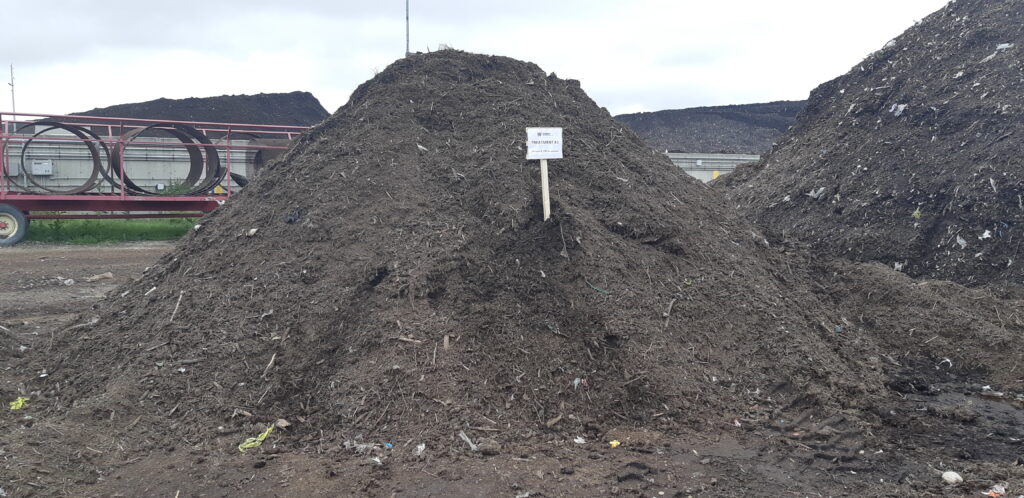
Features
Growing Media
Diverting stonewool from landfill
Diverting spent greenhouse growing media away from landfill into sustainable solutions.
April 7, 2022 By Lilian Schaer for Agricultural Adaptation Council
 Composted stonewool, leaf and yard waste. Stonewool was added at a ratio of 20% by volume. Photo courtesy of Walker.
Composted stonewool, leaf and yard waste. Stonewool was added at a ratio of 20% by volume. Photo courtesy of Walker. Research underway that could potentially divert thousands of tonnes of greenhouse vegetable production waste from landfills is showing early promising results.
Walker Industries (Walker) has partnered with Ontario Greenhouse Vegetable Growers (OGVG) on a project to evaluate the feasibility of collecting and recycling spent growing media from growers in the Leamington/Kingsville area.
Funded in part through the Greenhouse Competitiveness and Innovation Initiative (GCII) administered by the Agricultural Adaptation Council (AAC), the research also involves testing Walker’s composting process to determine whether it can successfully inactivate certain viruses like the Tomato Brown Rugose Fruit Virus (ToBRFV). ToBRFV is a highly destructive plant pathogen that can cause severe production losses in affected crops; it has spread to all the major greenhouse tomato growing regions of the world.
Stonewool (also referred to as rockwool) is one of the main substrates used by greenhouse vegetable growers in Canada to grow their crops. A mineral-based product spun into wool and enclosed in plastic, it provides structure for the roots of plants grown hydroponically (without soil).
Once used, most stonewool “slabs” currently end up in landfill, as do traditionally compostable materials like pepper and tomato vines to prevent the spread of ToBRFV.
“The goal is to eliminate the disposal of the spent growing media slabs and instead turn that waste into usable products. At the same time, we want to make sure that we can compost this material properly and effectively destroy any plant viruses, so we don’t inadvertently spread them around,” says Geoff Boyd, Vice President of Resource Recovery at Walker.
The research team is conducting trials to separate the plastic that surrounds the stonewool slabs and process the remaining material into a clean and usable product that is free of plastic contamination. The processed stonewool is then composted in Walker’s static aerated composting system. Prior to placement in the compost row, the infected material is secured in a specifically formulated vessel that allows the heat and air to pass through but prevents the stonewool from coming into contact with the other material in the compost row.
After the compost process is completed, a bioassay is used to determine if composting was effective in deactivating the virus. Samples of tomato tissue from the bioassay are sent to a testing lab to detect for the presence or absence of the virus.
“So far, the results are positive on the processing. We are now waiting on lab results from the bioassay tissue samples,” Boyd says, adding he hopes to have the project wrapped up with final results by this fall.
Once it is proven that composting successfully deactivates ToBRFV, the next step is to determine the best application for the finished composted product. To ultimately be successful, such a recycling and waste reduction venture must be cost competitive to some degree with traditional landfill disposal for it to make sense for greenhouse growers, but he’s hopeful that will be achieved.
“Keeping waste out of landfill is incredibly important and successful project results could provide a solution to help greenhouse growers increase the sustainability and competitiveness of their operations,” says AAC Chair Doug Alexander. “This project is an excellent example of a collaboration between growers and a business to trial innovative solutions that will contribute to long-term sustainability of the sector.”
According to Boyd, the GCII funding was invaluable to help Walker, a company that normally deals in food and yard waste, get this project off the ground in a meaningful way and conduct extensive trials and testing that wouldn’t otherwise have been possible.
Grodan, a leading manufacturer of stonewool based in Milton, has also been an active participant in the project and has worked collaboratively with Walker on addressing potential solutions.
“We are tremendously excited about these initial results. Potential solutions like this initiative are critical in stopping the spread of the rugose virus and diverting materials from the landfill,” says Yianni Monahan, Product Lifecycle Manager – North America, Grodan. “This project and Grodan’s collaboration with organizations like Walker are essential steps in fostering the most sustainable growing practices for the greenhouse growers of Ontario.”
“Ontario-based agri-food research is crucial for the sector,” says Lisa Thompson, Minister of Agriculture, Food and Rural Affairs. “Research like this will help greenhouse growers make informed decisions when seeking innovative solutions for waste reduction that will improve the productivity and sustainability of their operations.”
“In theory, this bulking agent will increase compost’s moisture content (since we receive rockwool at high moisture levels, with some nutrient leftovers as well), water holding capacity, porosity and nutrients, which all have a beneficial effect on the growth of the plants,” explains Dujmovic.
In a related project funded by the Ontario Centre of Innovation (OCI) and the Greenhouse Technology Network (GTN), Walker Industries partnered with Niagara College to investigate the use of rockwool as a compost quality enhancer by varying the compost-to-rockwool ratio.
This project is supported in part through the Greenhouse Competitiveness and Innovation Initiative, a cost-share program funded by the Ontario Government and delivered by the Agricultural Adaptation Council, on behalf of the Ontario Ministry of Agriculture, Food and Rural Affairs (OMAFRA).
Print this page